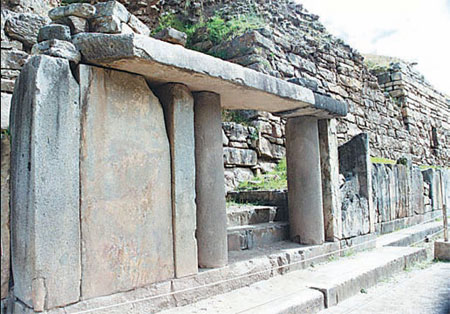Hidden gems of history
Updated: 2013-02-13 08:00
By Esha Chhabra (China Daily)
|
|||||||||||
|
Hampi, a UNESCO World Heritage site, is home to 500 temples and monuments clustered together in an old village in South India. Photos by New York Times |
|
The ruins of several pre-classic Mayan cities, including El Mirador, are hidden in the dense rain forest of northern Guatemala. |
|
Structures at Chavin de Huantar, about 240 km north of Lima, Peru. |
|
Banteay Chhmar in Cambodia has endured for more than 800 years without significant upkeep. |
Want to travel off the beaten track to heritage sites? If you think of Peru but not Machu Picchu, Cambodia but not Angkor Wat, India but not the Golden Triangle, here are some choices for you. Esha Chhabra reports.
A visit to well-known ancient sites like Machu Picchu in Peru often tops travelers' to-do lists. But unlike the serene journey to a pristine historic structure that you imagine, the real trip there often involves streets clogged with taxis, admission tickets with prices that will give you sticker shock and, once you're at the site itself, a thicket of camera-wielding tourists.
For every well-known site that draws hordes of visitors, there's another that is equally significant but often overlooked. Below are some of these hidden gems, drawn from the sites being restored by the Global Heritage Fund, a nonprofit organization based in Palo Alto, California, which works to preserve crumbling, looted, dismantled structures. Though these sites are not as well maintained as their better-known counterparts, they are worthy alternatives, having weathered centuries away from the spotlight.
Banteay Chhmar, Cambodia
Like Angkor Wat, Banteay Chhmar was commissioned by a 12th-century Khmer king. Surrounded by a moat and reservoir dotted with lotus flowers, the temple is a relic of the structures built in the great Angkorian Period, between the 9th and 15th centuries, during the height of the Khmer Empire. Unlike Angkor Wat, which underwent significant restoration starting in the late 1980s, Banteay Chhmar, about 160 kilometers northwest, has endured for more than 800 years without significant upkeep. Looted in the 1990s, part of the site has lost its original artifacts and structure, but the reliefs that remain, as well as a temple tower with a large face carved into the top, are reason enough to visit.
El Mirador, Guatemala
Traveling to El Mirador, tucked away in the Maya Biosphere Reserve of northern Guatemala, is an adventure. You must make a trek through dense rain forest for several days or pay up for a helicopter. Either way, the journey is worth it. The area contains the ruins of several pre-classic Mayan cities, including El Mirador, thought to be the largest. Among the remains is a towering structure called La Danta, a 70-meter-tall pyramid that is the most massive in the world. The structure is heavily subsumed by forest - which has not been cleared because it acts as a shield from the sun - but its summit has a sweeping view of the area.
Gobekli Tepe, Turkey
In southeastern Turkey, not too far from the city of Urfa, sit several giant carved stones, arranged in circular fashion. The formation may sound familiar, but the stones that make up Gobekli Tepe are more than 10,000 years old, predating Stonehenge by several millenniums. Moreover, these stones, which sit atop a hill that was rounded to accommodate them, retain reliefs of menacing animals like scorpions, snakes and wild boars. At least one archaeologist believes that the pillars are remnants of the world's oldest temple, but, whatever their provenance, they are impressive for having withstood the elements for thousands of years.
Hampi, India
While India's Golden Triangle (New Delhi, Agra and Jaipur) is a travel must for first-time visitors to the country, there are quite a few gems in South India that deserve note too. One of them is Hampi, the last capital of the Vijayanagara Empire, which is a UNESCO World Heritage site. This jewel box of a city, settled in the 14th century in what is currently the province of Karnataka, contains about 500 ancient temples and monuments clustered together in an old village. Standouts include two temples, the stone chariot and the Lotus Palace.
Chavin de Huantar, Peru
If you cannot bear to commune in the sacred plaza on Machu Picchu with dozens of strangers, consider Chavin de Huantar. About 240 km north of Lima at an elevation of more than 3,000 meters in the Andes, it was a religious and commercial center for the Chavin, one of the oldest major cultures in Peru before the Incas, dating from 1500 BC to 400 BC. There are fewer soaring structures at this UNESCO World Heritage site than at Machu Picchu, but there are remarkably intact stone carvings depicting fantastic figures. And the architectural intricacy of the space - which contains two temples, subterranean canals and plazas surrounded by stone platforms - suggests a powerful, influential society, one that archaeologists believe was nonviolent.
New York Times
Today's Top News
Police continue manhunt for 2nd bombing suspect
H7N9 flu transmission studied
8% growth predicted for Q2
Nuke reactor gets foreign contract
First couple on Time's list of most influential
'Green' awareness levels drop in Beijing
Palace Museum spruces up
Trading channels 'need to broaden'
Hot Topics
Lunar probe , China growth forecasts, Emission rules get tougher, China seen through 'colored lens', International board,
Editor's Picks

|

|

|

|

|

|









